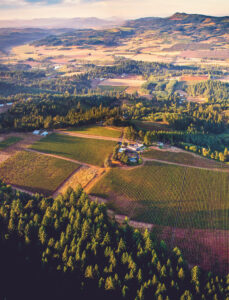For over fifty years, Oregon Aglink has had hundreds of members across the state who leverage its climate, daylight hours, and soils into a huge variety of agricultural products.
Whether they’re working in a wheat field, cranberry bog, dairy parlor, greenhouse, or any other place where Oregon agriculture happens, the members of Oregon Aglink have been keeping busy supplying products to consumers near and far.
“Oregon is famous for its agriculture,” says Jesse Lange of Lange Winery, “and the Willamette Valley is famous for being able to grow nearly anything.”
Lange is one of the latest members to join Oregon Aglink, part of a membership recruitment effort with the processing and manufacturing sector of Oregon agriculture. In particular, businesses like wineries, breweries, and distilleries transform agricultural products into award-winning beverages enjoyed around the state, the nation, and even the world.

Oregon wines, beers, ciders, and spirits can compete internationally, but they also serve as ambassadors to local agriculture, such as when someone in Portland enjoys a fresh-hopped beer from newly-joined Oregon Aglink member Gigantic Brewing.
Hops are typically dried and pelletized, a process that features in several other beers from Gigantic, but the limited runs of fresh-hop varieties each year become an occasion for story-telling. After deciding on a variety in late summer, head brewer Van Havig drives south from Portland to Sodbuster Farms, another Oregon Aglink member, to find Doug Weathers during harvest and return with a truckload of wet hops–two hundred pounds of them for every fifteen barrel kettle of the beer. The flavor is special, but so is the experience and the story Havig can share with customers or in between articles about local musicians and artists in their brewery magazine.

Other flavors of Oregon agriculture come into the mix at Gigantic Brewing and across town at Aimsir Distilling, another new Oregon Aglink member based in Portland. With the bounty of Oregon produce, it’s not uncommon to see a variety of fruits appearing in the beers, spirits, and cocktails.
While Oregon consumers may be familiar with local produce available fresh in season at their grocery stores, the processing of local fruits into purees and syrups means those favorites can show up year-round in all sorts of treats. At Aimsir Distilling, one of those treats is their Aitil House gin, which features peach and raspberry from Oregon Fruit Company in its complex profile of flavors.
Part of the Landscape
The introduction of commercial vineyards and American Viticulture Areas (AVAs) in the latter half of the twentieth century, as well as pockets of award-winning microbrewing and distilling around the state more recently, have all contributed to Oregon’s identity and economy. In some cases, as with the towering hop-yards of the Willamette Valley or the hillsides of Yamhill and other regions lined with vineyards, these industries have also had a visible place in the landscape.
Still, for all the talk of terroir in wine grapes or rare terpenes adding character to a hop varietal, sometimes the connection between the final product and its original landscape is something more familiar to other farms and ranchers in Oregon.
For the farms and vineyards growing the raw material for Oregon’s beverage industry, there’s a dance between staying ahead of the legislation guiding labor policy or water usage and the ever-higher benchmarks that play into marketing.
“You get a lot of buzzwords, and certifications are good to have,” says Jesse Lange, the second generation of wine-makers on their property, “but [many of us] live on the farms too, and that’s an element that ties us to the land.” For instance, an out-of-state investor or corporate entity might care about how a certain spraying practice affects their bottom line, but Lange echoes many other Oregon farmers: “You don’t think of it as a marketing thing, you just think of it as the responsible thing to do.” He’s not going to do something that he’s not willing to live with in his own backyard.
Hard Work and Creative Solutions
For beverage manufacturers with close ties to the farm work that produces their raw materials, they know all too well how the yearly work of growing hops and grapes is complicated by uncontrollable factors like weather.
“You have to be nimble, but there’s only so much you can do to be malleable for those kinds of week-to-week conditions.” says Lange about events like heat waves and winter ice storms. “You have a seed in the ground or a vine, and you work toward harvest. As farmers we should be good at that. It’s something we have to embrace rather than shy away from.”

The industry in general sees effects from the availability of certain products that get delayed or damaged by extreme weather events in a given year. With supply chains interrupted on a global scale, the ability to source local products is a benefit but nevertheless bears some risk. Plans change quickly if your next batch of beer or cider depends on fruit from an orchard whose yield took a hit in the heat dome last summer.
By the same token, trusted networks and creativity can produce new opportunities when disaster strikes.
For Stephen Hopkins at Aimsir Distilling, a batch of rosé tainted from recent wildfires came his way and will be the foundation of a new gin. The wine that wouldn’t have been sold or enjoyed in its original form will get a new life as the higher-proof gin “pushes through the smoke” in a way that another spirit might not have. The resulting product, “very Oregon-derived” in Hopkins’ words, can tell a unique story that highlights the challenges and ingenuity of agriculture and manufacturing in Oregon.
Whether the drink is enjoyed from a table overlooking the Dundee hills or in a noisy tap room in downtown Portland, every glass is a chance to toast Oregon agriculture and its contributions to our state.
By Allison Cloo.